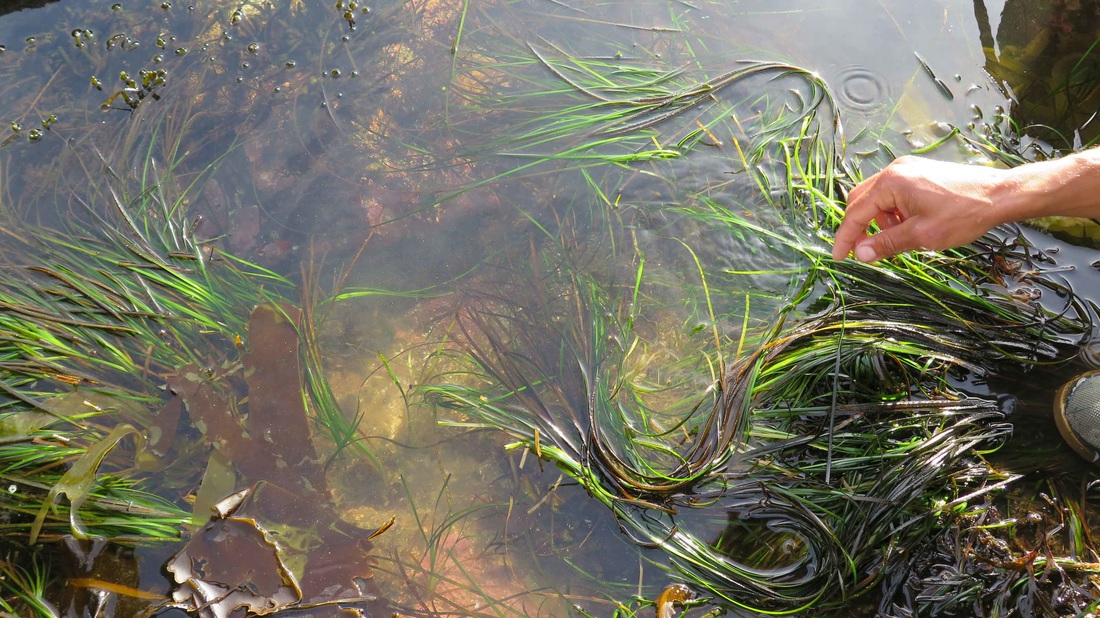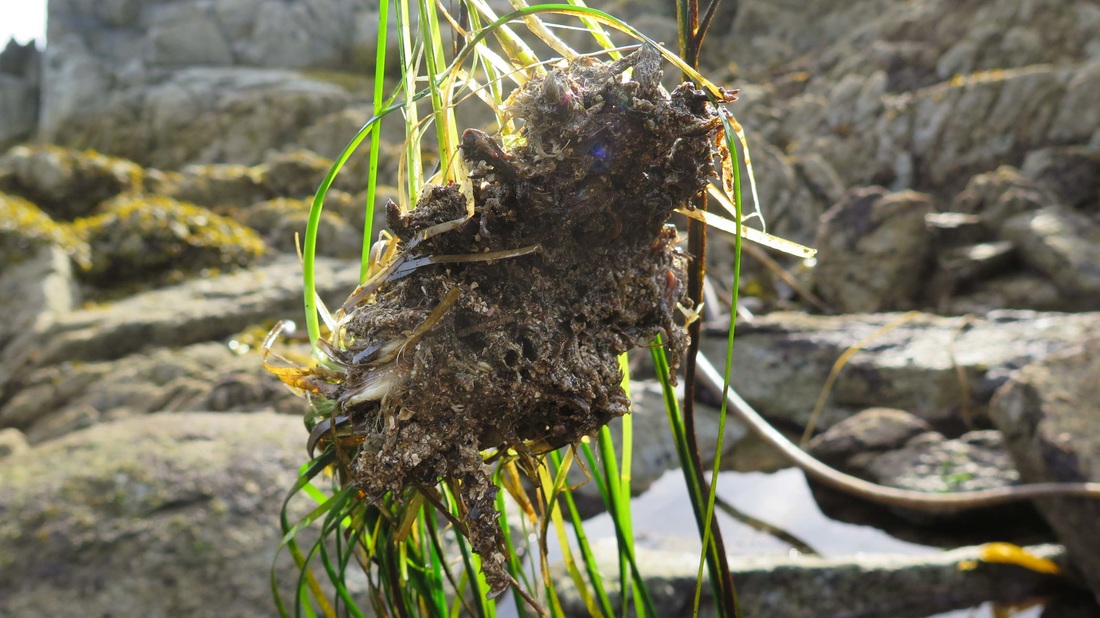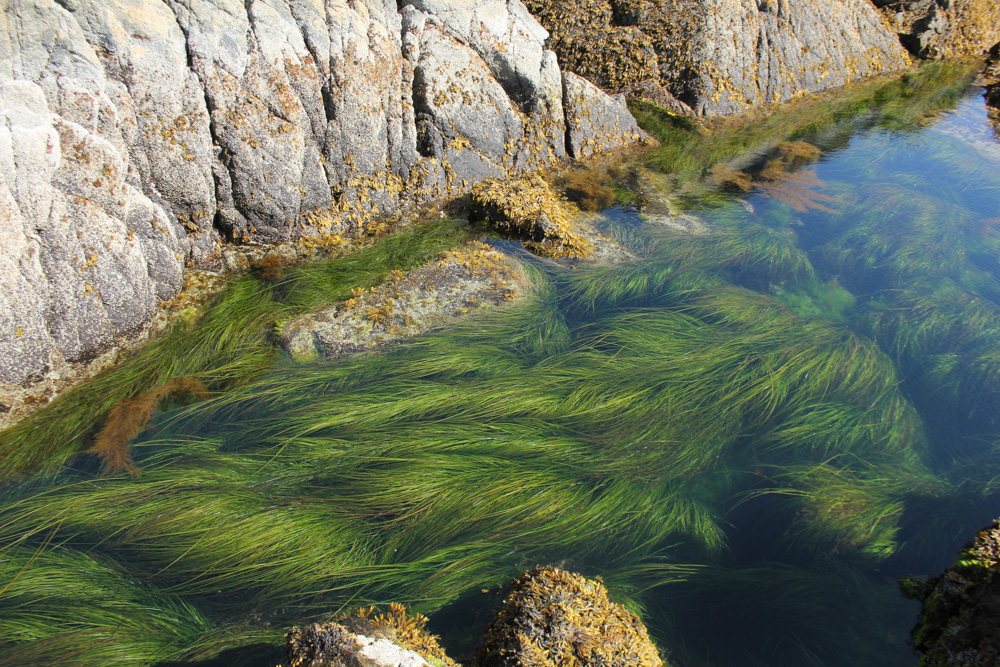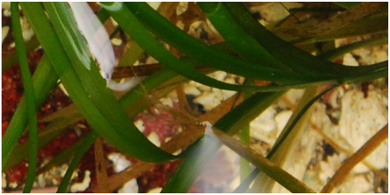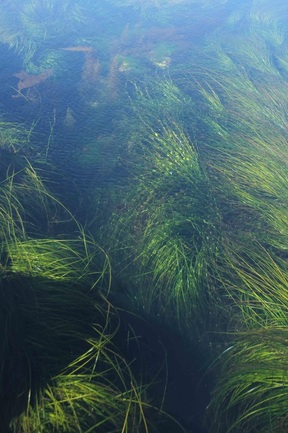Scouler's surfgrass, basket grass • Phyllospadix scouleri
Identification
Scouler's surfgrass is a perennial seagrass that grows from slender rhizomes, with 6-10 roots at each rhizome node. It produces stems annually; these stems are generally unbranched, and bear emerald green leaves in tufts. These leaves are usually 3-veined, though sometimes may be 5-veined. They reach 2 m long and 5 mm wide. In the summer Scouler's surfgrass bears a spiked, stalked inflorescence near its base; the fruit takes the form of a row of knobbly nutlets.
Habitat & Range
Scouler's surfgrass grows on rocks in the low intertidal and subtidal zones of exposed shorelines. Though it plays a role in settling suspended sediment, Scouler's surfgrass is generally found on rocks without sand coverage. It is a common species within its range from Sitka, Alaska to Mexico.
Similar Species
Scouler's surfgrass and serrulated surfgrass (Phyllospadix scouleri) were once considered a single species. The leaves of the latter have 5 or 7 veins, grow to 1 m long and are a bit wider (8 mm wide versus 5 mm), and have toothed margins that can be felt by running a finger along the leaf edge. It has paired roots at rhizome nodes. It also occurs higher in the intertidal.
Torrey's surfgrass (Phyllospadix torreyi) has narrower, wiry leaves (less than 2 mm wide) and branched stems. Eelgrass (Zostera marina) usually grows on soft substrates like sand, mud, and gravel.
Intriguing Info
Surfgrasses are extremely productive primary producers and provide habitat for many invertebrate and algae species, as well as nursery habitat for fish. They also play important roles in clarifying water, settling suspended sediment, and preventing erosion. Phyllospadix species are sensitive to water contamination from sewage and oil, and are slow to regenerate if the rhizome is destroyed. They are also sensitive to desiccation during low tide at middday. Click here to learn more about these plants.
iNaturalist
https://www.inaturalist.org/taxa/78561-Phyllospadix-scouleri
Scouler's surfgrass is a perennial seagrass that grows from slender rhizomes, with 6-10 roots at each rhizome node. It produces stems annually; these stems are generally unbranched, and bear emerald green leaves in tufts. These leaves are usually 3-veined, though sometimes may be 5-veined. They reach 2 m long and 5 mm wide. In the summer Scouler's surfgrass bears a spiked, stalked inflorescence near its base; the fruit takes the form of a row of knobbly nutlets.
Habitat & Range
Scouler's surfgrass grows on rocks in the low intertidal and subtidal zones of exposed shorelines. Though it plays a role in settling suspended sediment, Scouler's surfgrass is generally found on rocks without sand coverage. It is a common species within its range from Sitka, Alaska to Mexico.
Similar Species
Scouler's surfgrass and serrulated surfgrass (Phyllospadix scouleri) were once considered a single species. The leaves of the latter have 5 or 7 veins, grow to 1 m long and are a bit wider (8 mm wide versus 5 mm), and have toothed margins that can be felt by running a finger along the leaf edge. It has paired roots at rhizome nodes. It also occurs higher in the intertidal.
Torrey's surfgrass (Phyllospadix torreyi) has narrower, wiry leaves (less than 2 mm wide) and branched stems. Eelgrass (Zostera marina) usually grows on soft substrates like sand, mud, and gravel.
Intriguing Info
Surfgrasses are extremely productive primary producers and provide habitat for many invertebrate and algae species, as well as nursery habitat for fish. They also play important roles in clarifying water, settling suspended sediment, and preventing erosion. Phyllospadix species are sensitive to water contamination from sewage and oil, and are slow to regenerate if the rhizome is destroyed. They are also sensitive to desiccation during low tide at middday. Click here to learn more about these plants.
iNaturalist
https://www.inaturalist.org/taxa/78561-Phyllospadix-scouleri
References
Lamb, A., and Hanby, B. (1999). Marine Life of the Pacific Northwest. Madeira Park, BC: Harbour Publishing. P. 213.
Phyllospadix scouleri Hook. In Klinkenberg, Brian. (Ed.). E-Flora BC: Electronic Atlas of the Plants of British Columbia. Lab for Advanced Spatial Analysis, Department of Geography, University of British Columbia, Vancouver. Accessed 16/09/2013.
Phyllospadix (Surfgrass). Pacific Rocky Intertidal Monitoring: Trends and Synthesis. Ecology and Evolutionary Biology, University of California Santa Cruz. Accessed 16/09/2013.
Authors and editors of page
Kelly Fretwell and Brian Starzomski (2013).
Lamb, A., and Hanby, B. (1999). Marine Life of the Pacific Northwest. Madeira Park, BC: Harbour Publishing. P. 213.
Phyllospadix scouleri Hook. In Klinkenberg, Brian. (Ed.). E-Flora BC: Electronic Atlas of the Plants of British Columbia. Lab for Advanced Spatial Analysis, Department of Geography, University of British Columbia, Vancouver. Accessed 16/09/2013.
Phyllospadix (Surfgrass). Pacific Rocky Intertidal Monitoring: Trends and Synthesis. Ecology and Evolutionary Biology, University of California Santa Cruz. Accessed 16/09/2013.
Authors and editors of page
Kelly Fretwell and Brian Starzomski (2013).
